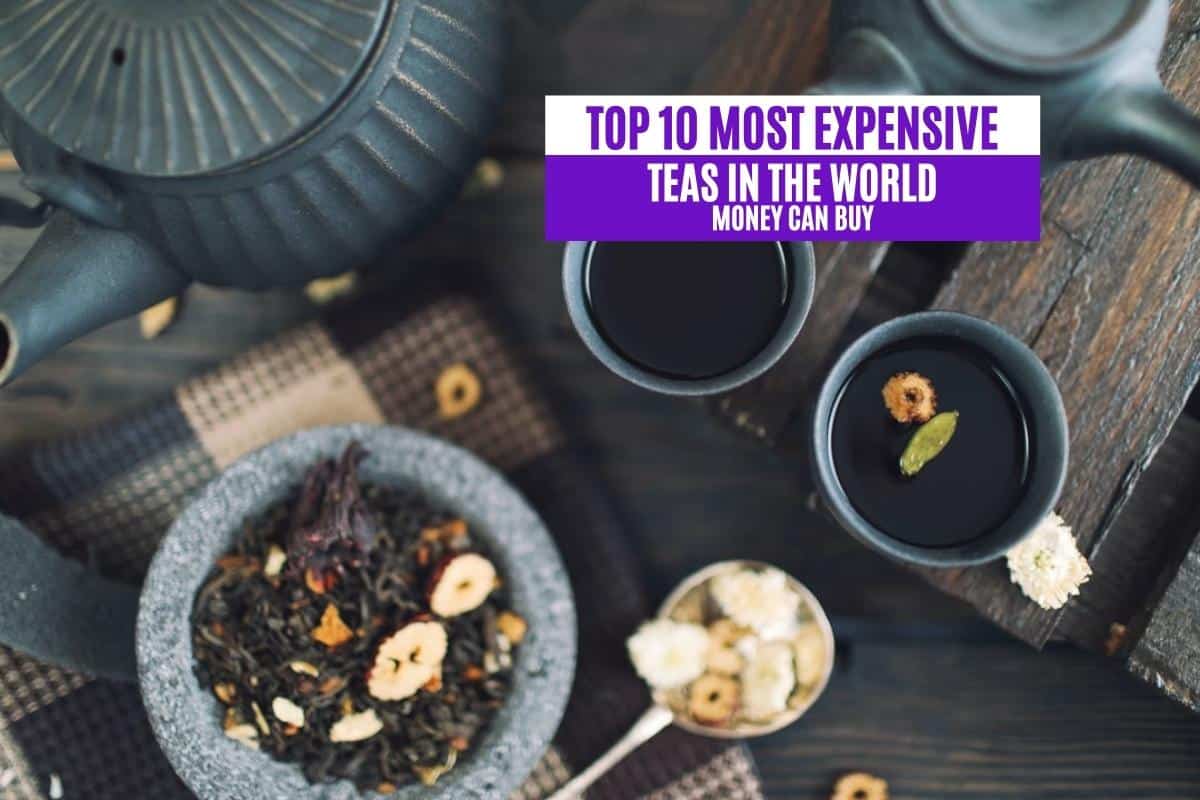The first tea plants were cultivated in China almost 4,500 years ago. So it’s no surprise that many of the most expensive teas enjoyed worldwide come from China. But which of these tea strains is the priciest?
The most expensive tea is Dong Hong Pao, mainly tea made from the dried leaves of ancient Dong Hong Pao tea plants in Wuyishan, China. A single pound of this rare tea starts at $645,000, though prices are often higher. Panda Dung tea is almost as pricey, costing about $31,700 per pound.
If you’ve got a thirst for some of the costliest, most decadent, and rarest teas, this ranking can help you select a strain that’s well suited to your palate and budget.
Here Are the Top 10 Most Expensive Teas in the World:
- Original Dong Hong Pao – $645,000 Per Pound
- Panda Dung – $31,700 Per Pound
- Uji Gyokuro – $9,752 Per Pound
- TWG Yellow Gold Tea Buds – $3,800 Per Pound
- Vintage Narcissus – $3,250 Per Pound
- Ge Mian Sheng Puerh – $600 Per Pound
- Tienchi Flower – $367 Per Pound
- Silver Tips Imperial – $272 Per Pound
- Vintage Oak Barrel Aged Pu Erh – $250 Per Pound
- Gao Shan Qing Xin Oolong – $136 Per Pound
10. Gao Shan Qing Xin Oolong – $136 Per Pound
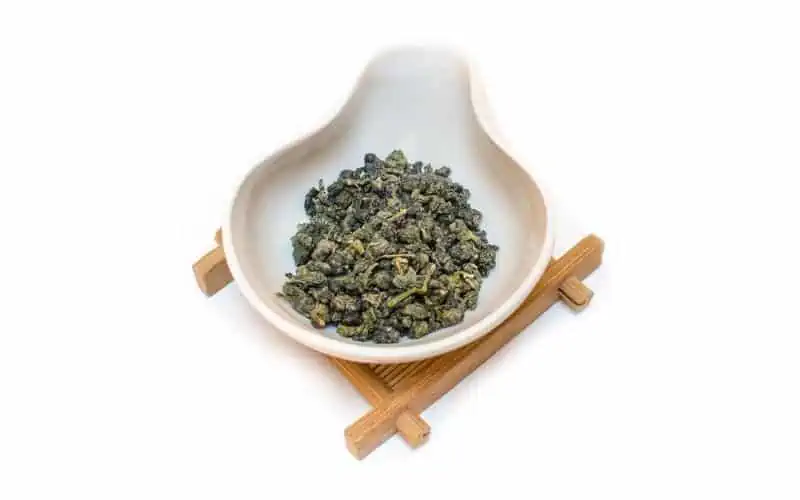
Taiwan might not be the leading provider of high-quality tea, but it does offer a few top-notch strains that are sure to suit your tastes. Gao Shan Qing Xin Oolong is an excellent example.
This floral tea is brewed from pearl-like leaves that gently unfold when exposed to hot water. It produces a bright, honey-yellow drink that’s surprisingly smooth and sweet.
While this tea only costs $136, far less than many of the other teas included in this ranking, there are a few ways to spice things up. For example, you might consider adding a gentle pour of one of the most expensive kinds of milk!
Why It’s Expensive
Gao Shan Qing Xin Oolong tea is more expensive than your average oolong due to its exceptional flavor profile and growing location. This tea grows along the borders of the Alishan National Scenic Area, one of the most beloved natural areas in the beautiful country of Taiwan.
9. Vintage Oak Barrel Aged Puerh – $250 Per Pound
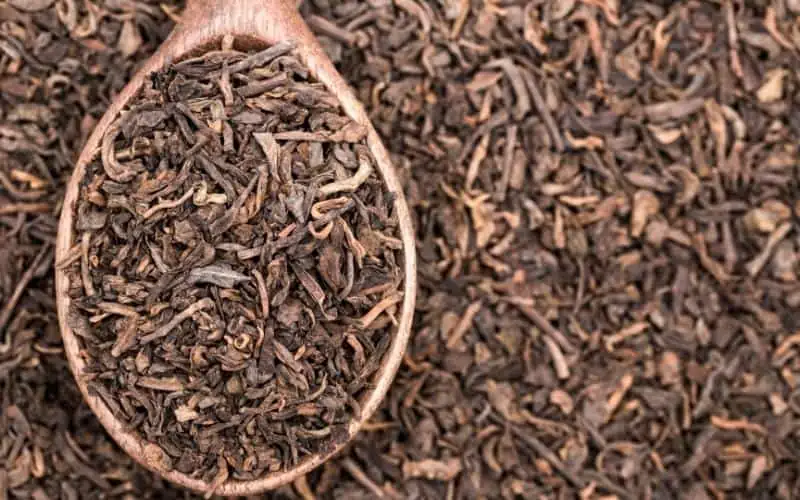
It’s not uncommon for beers or liquors to spend some time aging inside an oak barrel. But what about tea leaves? That’s the question The Teahouse Santa Fe asked themselves before they decided to store their 2001 harvest inside oak barrels.
This resulting vintage tea is a cacophony of complex flavors, each one melding perfectly together to form a distinct taste that’s impossible to replicate. Rich in caffeine and overflowing with flavor, this tea could be an excellent choice for coffee lovers and wine drinkers.
Even better, you’ll only need to spend $250 to enjoy a pound of this tea!
Why It’s Expensive
Time is the primary reason this tea is so expensive. After all, these tea leaves were harvested more than two decades ago, making them an incredibly rare find.
The chance to taste a tea grown in 2001 doesn’t often present itself, so you might want to snap up a few pounds before this strain disappears.
8. Silver Tips Imperial – $272 Per Pound
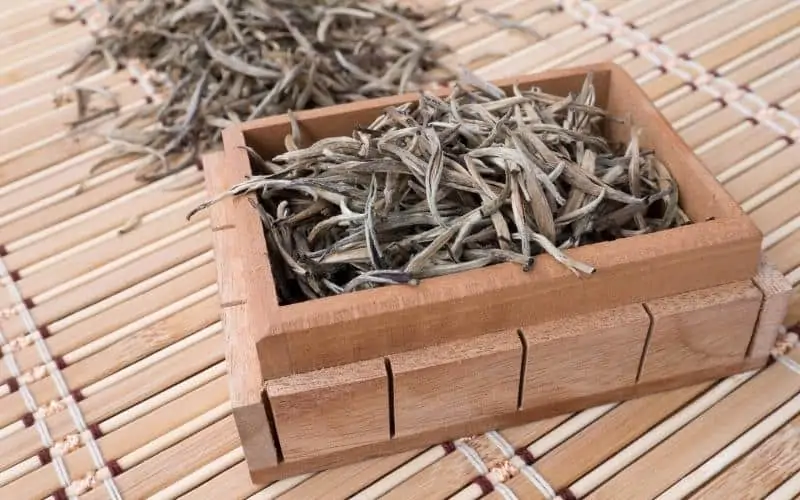
The Silver Tips Imperial tea picked in Darjeeling, India is far pricier than other types of oolong tea. But it’s not challenging to understand why, especially when you learn how this tea is grown and harvested.
This type of tea is grown in the mountainous forests in Darjeeling. But its silver-hued leaves are only plucked when a full moon lights up the night sky. As such, harvest schedules can be challenging to maintain.
But the effort is more than worth it, as this tea has an earthy, fruity flavor often described as transcendent. But you’ll need to spend at least $272 per pound for the chance to experience this tea-based enlightenment.
Why It’s Expensive
The labor required to harvest this tea during moonlit nights significantly increases its cost. Additionally, Silver Tips Imperial is a popular luxury-quality tea due to its potential health benefits.
As such, labor costs and a high demand tend to force the price of this tea ever upward.
7. Tienchi Flower – $367 Per Pound
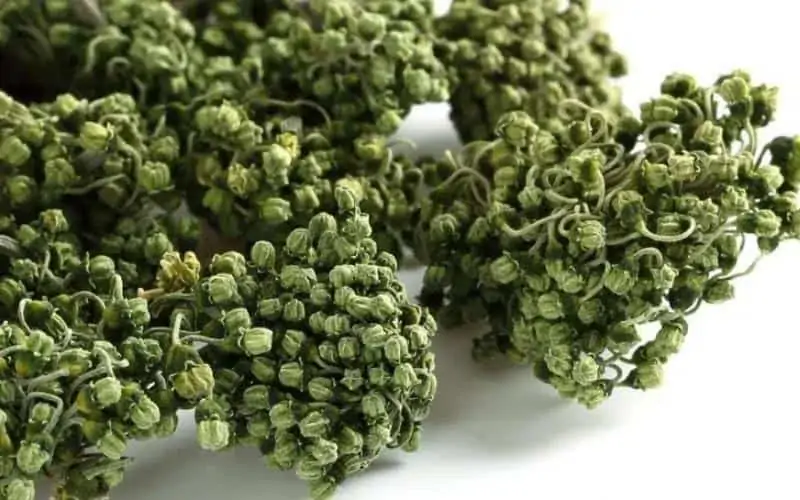
Tienchi Flower tea looks unlike any other type of tea in the world. For example, instead of needle-like or pearl-like leaves, these tea leaves resemble bright green miniature pine cones.
It’s also used extensively as a homeopathic aid due to its purported heart-healthy benefits. As one of the primary ingredients used in Traditional Chinese Medicine (TCM), Tienchi Flower tea is always in high demand. A single pound costs more than $350.
Why It’s Expensive
Though this variety might not be the tastiest (the flavor is often described as earthy, with a slightly minty aftertaste), its reputation as one of the healthiest teas contributes to its noteworthy price.
6. Ge Mian Sheng Puerh – $600 Per Pound
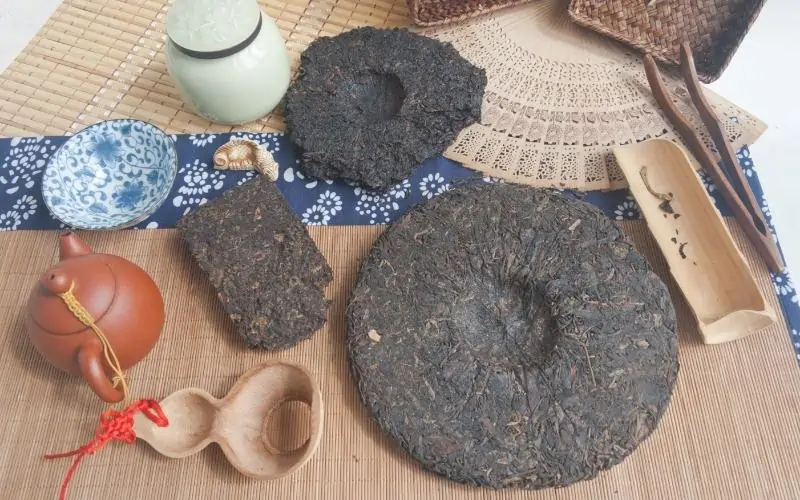
Chinese Puerh tea isn’t like standard loose-leaf varities. Firstly, this tea is formed into flat discs instead of stuffed into tiny tea bags or sachets. This practice helps the tea resist molding from excess moisture, as the hard round servings of tea are relatively resistant to humidity.
The Ge Mian Sheng Puerh is one of the most exquisite varieties. Grown in 2018, this tea disc is slightly aged, allowing the flavors of the leaves to develop more complex notes.
Every golden cup of this tea has a slightly sweet, fruity taste. But if you allow the disc to age a few more years, that flavor profile may change!
Why It’s Expensive
This tea was harvested from tea plants said to be more than a century old, and the resulting leaf discs are often aged for several years before hitting store shelves. These two qualities help make Ge Mian Sheng Puerh tea one of the priciest options.
5. Vintage Narcissus – $3,250 Per Pound
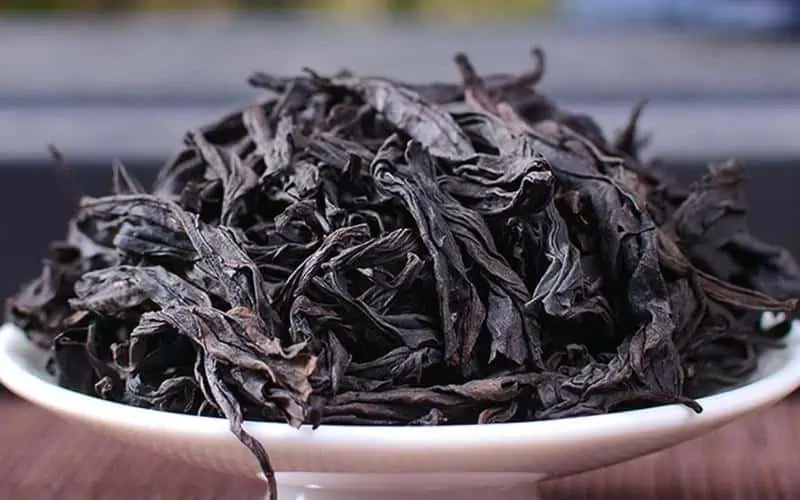
As the name suggests, Vintage Narcissus tea is an aged tea originating from the Wuyi Mountains in China. The dried leaves have a distinct brownish-violet hue and are often dried repeatedly over several years or decades.
The resulting flavor profile is fantastically complex, often featuring notes of chocolate but with a strong woody undertone. But unfortunately, this tea is in short supply. So acquiring a pound of Vintage Narcissus for $3,250 or less is an absolute steal.
Why It’s Expensive
Keeping dried tea leaves in excellent condition for several decades is challenging and labor-intensive. As a result, the oldest Vintage Narcissus teas are rare and incredibly expensive.
4. TWG Yellow Gold Tea Buds – $3,800 Per Pound
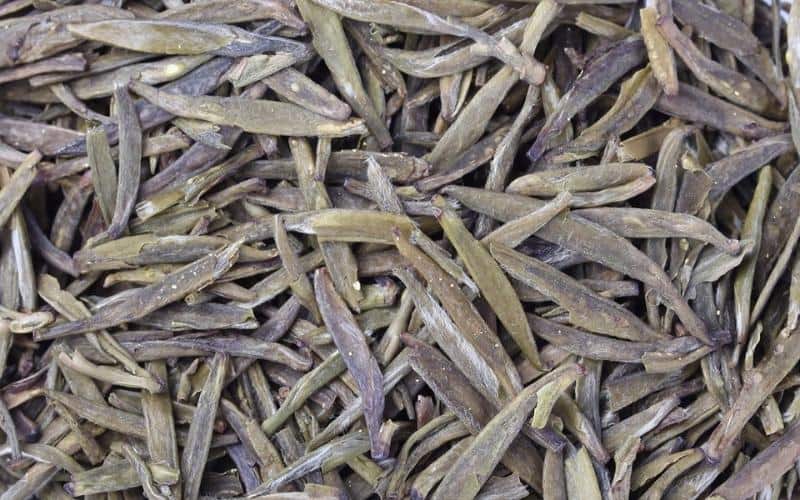
TWG is a Singaporean brand that’s internationally recognized for producing some of the finest gourmet teas in the world. One of their priciest and most decadent options is the TWG Yellow Gold Tea Buds.
These tea leaves are harvested only one day each year, and they’re only grown on a single mountain in China. As such, this tea is scarce. But their scarcity isn’t the only factor contributing to their high price tag.
Each of these tea leaves is gently coated in 24-karat gold. When brewed, the resulting tea is a shimmering golden cup of absolute delight. At $3,800 per pound, you’re spending almost $21 per cup.
Why It’s Expensive
There are quite a few reasons why this Singaporean tea is one of the most expensive. Firstly, the plants used to produce these tea leaves are located in a remote region of China. Additionally, leaves can only be harvested once each year.
As a result, the supply of TWG Yellow Gold Tea Buds is almost always low. The fact that these tea leaves are covered in gold also contributes to the high price of this opulent beverage.
3. Uji Gyokuro – $9,752 Per Pound
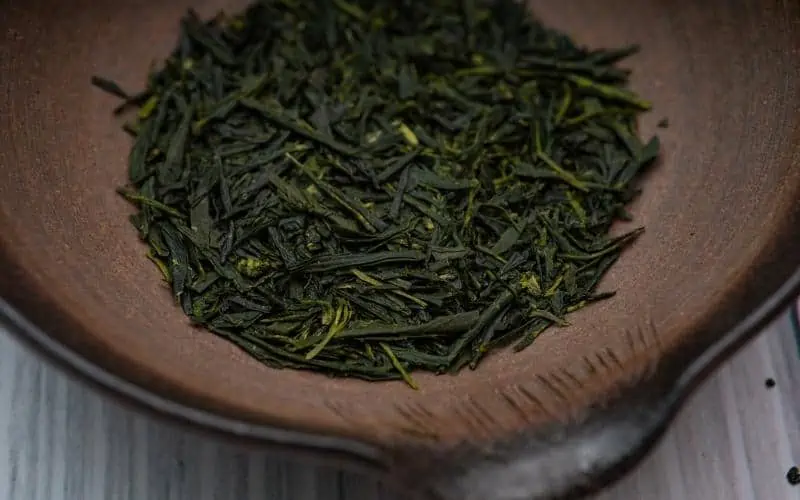
The Japanese take their tea drinking very seriously. Japanese tea plants are the result of centuries of dedication and care, and it shows in the quality of their leaves. So, if you’d like to try one of the best Japanese teas, you’ll likely want to choose the 2021 National Competition winner, Uji Gyokuro.
Also known as Jade Tea, this strain comes from multiple cultivars throughout Japan. But the competition-winning Uji Gyokuro might be the most expensive of the lot, costing $9,752 per pound.
When brewed, these leaves produce a delicate yellow tea with a floral flavor that’s ever so slightly sweet.
Why It’s Expensive
While you can find Jade Tea for sale at lower prices, Uji Gyokuro is Japan’s national tea competition winner, making it a highly desirable option. Due to the high demand for this strain, prices aren’t likely to drop soon.
2. Panda Dung – $31,700 Per Pound
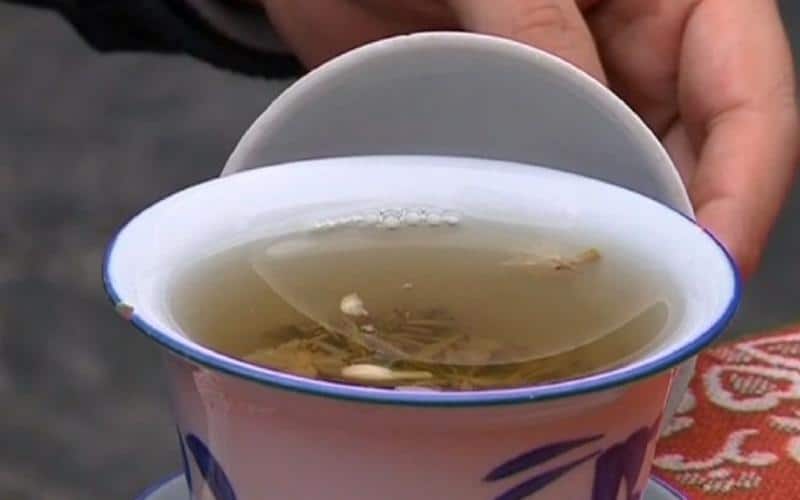
Though the name of this tea might not sound very appetizing, Panda Dung tea is one of the most popular (and pricey) teas exported from China. As the name suggests, this strain is cultivated in panda poop.
This process is thought to imbue the tea plants with a wealth of nutrients, making it one of the most popular homeopathic teas in the world. The flavor of Panda Dung tea is often described as nutty or earthy, though it seems that most people aren’t drinking it for its flavors.
If you’d like to try out the potentially health-boosting effects of this tea for yourself, be prepared to spend about $31,700 per pound.
Why It’s Expensive
Many people would like to try a cup of Panda Dung tea, either out of pure curiosity or for the purported health benefits. However, the supply of this unique tea is limited.
Panda poop can be challenging to acquire, especially since the population of wild pandas in China has only recently increased to unendangered levels. As such, the prices for this type of Chinese tea will likely remain high until there are more pandas available to help fertilize the tea plants.
1. Original Dong Hong Pao – $645,000 Per Pound
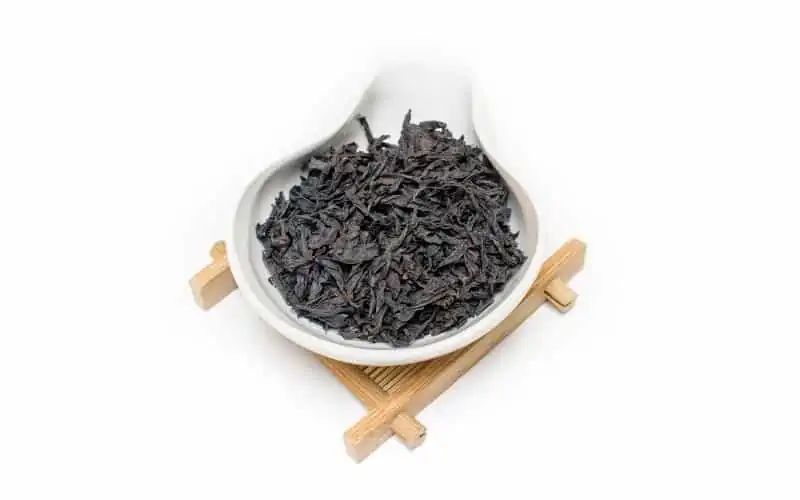
The most expensive tea in the world is Dong Hong Pao. This incredible Chinese tea doesn’t pull any gimmicks—it isn’t covered in gold flakes or fertilized by panda poop. However, it is one of the oldest varieties of tea that’s still cultivated and enjoyed today.
The priciest Dong Hong Pao tea bundles come from only a handful of ancient bushes, half of which purportedly date back to the 13th century.
While most tea plants are lucky to live for 50 years, China claims that three of its prized Dong Hong Pao plants have been around since the Song Dynasty. Considering how closely these tiny shrubs are guarded, this legend may be true.
Either way, you can expect to spend upwards of $645,000 per pound on these oolong tea leaves. Still, you’ll be rewarded with a tea with one of the most complex flavor profiles of any beverage.
The fortunate few who’ve managed to get their hands on these treasured tea leaves describe the taste as earthy, slightly sweet, and incredibly fragrant.
Why It’s Expensive
Dong Hong Pao tea’s incredible prices stem from the fact that the leaves may come from the oldest tea bushes in the world. Unfortunately, only six of these bushes remain, so the chance to take a sip of this tea is limited.
Essentially, a minimal supply (coupled with an incredible story) makes Dong Hong Pao tea unbelievably expensive.
Why Are Some Teas So Expensive?
A pound of traditional black tea only costs an average of about $11. So why do some teas cost hundreds or thousands of dollars per pound?
There are three crucial factors influencing the price of any given tea. These factors are:
- Rarity
- Labor
- Flavor
Understanding how these elements raise or lower tea prices is essential when choosing a luxury-quality tea. So, without further ago, let’s take a closer look at these factors.
Rarity
Like many of the world’s most expensive fish, the priciest teas are often incredibly rare. There are several reasons for this scarcity.
For example, the tea in question might only come from specific regions or a limited number of tea plants. Additionally, aged teas tend to be rarer than freshly dried teas.
These gourmet types of tea are often in high demand, which also reduces supply. As the law of supply and demand states, any high-demand commodity in low supply is naturally bound to experience higher prices.
Labor
Some of the most expensive, luxury-grade teas require an insane amount of labor to produce. For example, the priciest Silver Tips Imperial teas contain leaves picked only under the light of a full moon.
Because the harvest period is limited, hundreds of workers must work in tandem to pluck the tea plants before the sun rises. You can imagine how expensive it is to hire and maintain such a labor force!
But tea retailers don’t shoulder these costs. Instead, they pass them onto the consumer via higher-than-average prices.
When you choose an expensive, high-quality tea, you’re likely choosing a product that’s the result of intensive labor. Hopefully, you’re also choosing a mouthwatering beverage that’s flavorful and smooth.
Flavor
Several of the costliest teas are rich in flavors, making them popular among the most passionate tea connoisseurs. For example, the TWG Yellow Gold Tea Buds have a distinctly metallic taste, partially due to the 24-karat gold applied to the surface of each leaf.
Buyers looking to experience the most refined tea drinking experience will naturally gravitate toward options with unique flavors. Teas flavored by some of the world’s most expensive spices are also in high demand. They’re also far costlier than your average sachet of black tea.
What Is the Most Expensive Tea?
The most expensive tea in the world is Dong Hong Pao, particularly the dried leaves from the few remaining ancient plants surviving in Wuyishan, China. These plants are said to be several centuries old, allowing them to develop unique flavors that harken back to long-ago eras.
But if you’d like to try another pricey Chinese tea, you might want to opt for Panda Dung tea leaves. These leaves come from tea plants fertilized with panda poop, a relatively rare type of organic fertilizer.
For more information about the world’s most expensive and luxurious beverages, check out these related articles!

